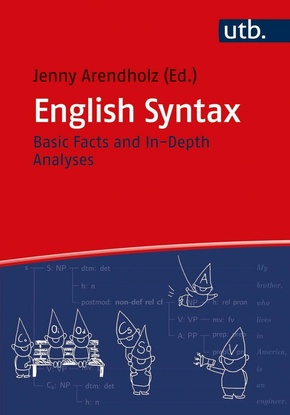
English Syntax - Basic Facts and In-Depth Analyses
| Verlag | UTB |
| Auflage | 2022 |
| Seiten | 360 |
| Format | 15,3 x 2,2 x 21,5 cm |
| Gewicht | 525 g |
| Artikeltyp | Englisches Buch |
| ISBN-10 | 3825256553 |
| EAN | 9783825256555 |
| Bestell-Nr | 82525655A |
This collection of pivotal issues about syntactic analysis bridges the gap between two extremes: Quirk et al.'s classic, yet voluminous standard grammar The Comprehensive Grammar of the English Language (CGEL, 1985) and slim booklets with sample solutions. Written for students and teachers alike, this textbook introduces basic concepts, deepens preexisting knowledge, prepares students for various exam contexts and provides hands-on teaching material. Each chapter provides theoretical explanations, which are immediately illustrated by numerous complete sample analyses of sentences taken both from the CGEL as well as from more recent British and American news articles. The final part of this textbook offers a comprehensive practice section for self-study using sentences which are divided into three levels of difficulty and come with model solutions.
Inhaltsverzeichnis:
PrefaceList of abbreviations (alphabetical order)List of abbreviations (structural order)1 Basic Introduction and Syntactic Functions - Jenny Arendholz1.1 Some Structural Facts and Layout Conventions1.2 The Seven Syntactic Functions1.3 Tricky Business: Oi vs. Oprep2 The Internal Structure of Phrases - Jenny Arendholz2.1 Characteristic Features of Phrases2.2 The Noun Phrase (NP)2.3 The Adjective Phrase (AdjP) and the Adverb Phrase (AdvP)2.4 The Verb Phrase (VP)2.5 The Prepositional Phrase (PP)2.6 Tricky Business2.6.1 Nouns in the Premodifier Slot of NPs2.6.2 Embedding2.6.3 Complementation2.6.4 Complex Determinatives3 Word Classes - Michaela Pitsch3.1 Nouns3.2 Adjectives and Adverbs3.3 Adjectives vs. Adverbs3.4 Pronouns and Determiners3.5 Pronouns vs. Determiners3.6 Prepositions and Conjunctions3.7 Prepositions vs. Subordinating Conjunctions3.8 Adverbs vs. Subordinating Conjunctions3.9 Numerals3.10 Words of Unique Function3.11 Tricky Business3.11.1 Some as an Adverb3.11.2 Change of Word Class4 The Verb - Sandra Neigefind4.1 Distinction According to Word Class4.1.1 Full Verbs4.1.2 Modal Auxiliary Verbs4.1.3 A Special Case of Modals: Catenative Verb Constructions4.1.4 Primary Verbs4.2 Copular Verbs4.3 Multi-Word Verbs4.3.1 Phrasal Verbs4.3.2 Prepositional Verbs4.3.3 Phrasal-Prepositional Verbs4.3.4 Detection Rules5 An Introduction to Complex Sentences - Hannah Jahner & Jenny Arendholz5.1 Clauses vs. Phrases5.2 Sentences and Clause Combinations5.3 Subordinate Clauses5.3.1 Nominal Clauses5.3.2 Adverbial Clauses5.4 Embedded Clauses5.5 Summary: Syntactic Functions of Dependent Clauses6 Finite Clauses - Jenny Arendholz & Michaela Pitsch6.1 Adverbial Clauses6.2 Wh-Clauses6.3 That-Clauses6.4 Attributive Relative Clauses6.5 Nominal Relative Clauses6.6 Sentential Relative Clauses6.7 Comparative Clauses6.8 Tricky Business: Is that Still a Problem?7 Non-Finite Clauses and Verbless Clauses - Lioba Arnoldi7.1 -ing-Participle Clauses7.1.1 Subordinate -ing-Participle Clauses 7.1.2 Attributive -ing-Participle Clauses7.2 -ed-Participle Clauses7.2.1 Subordinate -ed-Participle Clauses7.2.2 Attributive -ed-Participle Clauses7.3 to-Infinitive Clauses7.3.1 Subordinate to-Infinitive Clauses7.3.2 Attributive to-Infinitive Clauses7.4 Bare Infinitive Clauses7.5 Verbless Clauses7.6 Tricky Business7.6.1 Catenative Verbs and Non-Finite Forms7.6.2 Gradience in Non-Finite Clauses8 Appositions - Franziska Kirchhoff8.1 Definition and Terminology8.2 Different Forms of Apposition8.2.1 Phrasal Apposition8.2.2 Clausal Apposition8.3 Indicators of Apposition8.4 Tricky Business8.4.1 The Appositive of-Phrase8.4.2 Distinguishing Apposition from Coordination9 Coordination - Jenny Arendholz9.1 Terminology and Basic Structures9.2 Coordinators9.3 Types of Coordination9.4 The Analysis of Coordination9.4.1 The Ellipsis Strategy9.4.2 The Conjoint Strategy9.4.3 The Shift Strategy9.4.4 Detection Rules10 Means of Emphasis and Other Deviating Sentence Patterns - Jenny Arendholz10.1 Theme and Rheme10.2 Fronting and Inversion10.3 Cleft Sentences Proper and Pseudo-Cleft Sentences10.4 Extraposition of Clausal Subjects and Objects10.5 Existential Constructions11 Practice Makes Perfect - Britta van den Berg & Jenny Arendholz11.1 Easy Sentences11.2 Moderate Sentences11.4 Difficult SentencesReferencesPrimary SourcesSecondary SourcesSecondary Online SourcesIndex
